Top News
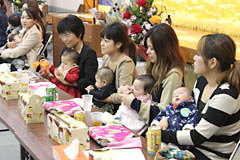
December 28, 2012 Ryukyu Shimpo
On December 25, at the Kushi Community Center in Nago, a traditional Christian festival was held to bless children born that year. About 100 participants celebrated babies born from January to November and 13 parents, prayed for the healthy growth of their children. The people of the community contributed a range of performances and Kiyotaka Higa, head of the district, presented cash contributions to the babies and their parents. Higa said, “Children are treasures. I hope that all our residents help look after them as though they were your children.”
Kiminori Higa, who participated with his son Sukai, born in January, was delighted, saying, “My birth was celebrated in this way in the Christian festival and now, as a father, I celebrate the birth of a son. This is a happy occasion for me.”
Higa’s sister, Kumiko Kadekaru, took part in the festival with her two-day old baby Yuki, so this day was doubly enjoyable for the brother and sister.
According to Kushi Village records, this event has the historical backdrop in which residents submitted a list of newborn babies to the royal government during the Ryukyu Kingdom era, during which Christianity was banned.
(English translation by T&CT, Mark Ealey)
Go to Japanese
December 30, 2012 Ryukyu Shimpo
On December 28, a Marine corporal was arrested in Naha on trespassing charges, and the next day, on December 29, Naha Police arrested a Marine lance corporal on suspicion of driving under the influence of alcohol. The lance corporal’s vehicle collided with a motorbike ridden by an Okinawan man. According to the police, a breath test indicated that the suspect had four times the legal limit of alcohol (breath alcohol concentration of 0.15 milligrams per liter) in his system. On the same day, the police station handed the Marine corporal suspected of having entered the veranda of an apartment on December 28, over to the Naha District Prosecutor’s Office. That these incidents involving U.S. servicemen occurred on consecutive days is likely to cause Okinawan people to further criticize the U.S. military for not preventing crimes and incidents involving their personnel.
According to the police, they arrested a 24 year-old serviceman from the Marine Corps’ Makiminato Service Area in Urasoe on suspicion of driving under the influence of alcohol. The police said he remained silent during questioning. The man on the motorbike suffered slight injuries, complaining of pain in his legs. At around 5:25pm, the suspect allegedly drove a vehicle while under the influence of alcohol the wrong way up a one-way street in the Kumoji district of Naha and collided with the man riding the motorbike. A passerby who witnessed the accident reported it to the police. They confirmed that alcohol was involved, and immediately arrested the Marine lance corporal.
(English translation by T&CT, Mark Ealey)
Go to Japanese
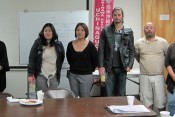
December 24, 2012 Sadao Tome Correspondent of Ryukyu Shimpo
Two months have passed since it was decided that the 2nd Worldwide Youth Uchinanchu Festival will be held in Los Angeles around July 2013. Two representatives from Okinawa have already been to the United States, and on November 9 three members living in the United States visited the Okinawa Association of America. Those three also participated in the 5th Worldwide Uchinanchu Festival as representatives of American youth, and since then have had ongoing discussions through Skype once a week.
They met on this occasion to discuss the location of the next festival and to get to know each other. The members who visited Los Angeles are Natsuki Fukuhara Marsh from Uruma, but now living in Alabama, Noriko Inafuku from Nanjo, now living in Seattle, Washington and Itsuki Gramkow Yokota from Uruma and now living in Houston, Texas.
Gramkow participated in the Worldwide Youth Uchinanchu Festival Brazil 2012. Reflecting back on the World Festival held in Naha in 2011, Marsh stated that it was the second time for her to participate, and that she was proud of having been born in Okinawa and to see people gathered from all over the world. Inafuku said that the opening ceremony was particularly memorable for her. Gramkow, who has an American father and an Okinawan mother, talked about his identity as a representative of youth at the closing ceremony. He said that he is proud that he is an Uchinanchu and gave a speech designed to inspire others.
According to Yuko Yamauchi, the executive chairperson of the Okinawa Association of America, they expect a total of 150 people to participate in the Worldwide Youth Uchinanchu Festival, including 80 people from the United States and 70 from Okinawa and other countries. Youth is defined as people between the ages of 18 to 35 years, and the festival accepts observers depending on the nature of the event. They will put together the detailed program from now. One of the representatives from Los Angeles, Hiroshi Yamauchi from Okinawa City, looked after the three members.
After staying three days and two nights, the three left Los Angeles promising each other that they will meet at the festival next year.
(English translation by T&CT, Lima Tokumori and Mark Ealey)
Go to Japanese
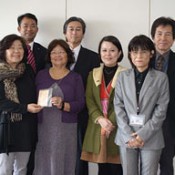
December 23, 2012, Ryukyu Shimpo
On December 20, an old military postcard was returned home to a bereaved family in Okinawa. About 70 years ago, Japanese soldier Ryobun Kuwae wrote this card and sent it to his friend. When Kuwae’s daughter Takako received the card from Katsue Garner, she said, “It’s significant that the card was returned on December 14, which is the 13th anniversary of my father’s death.”
Garner is originally from Nishihara, and currently resides in Georgia, in the United States. She married a U.S. soldier and left Okinawa in 1965. About 20 years ago she was given this postcard by her friend whose brother was also in the U.S. military.
This is Garner’s first visit home in 47 years, and she asked one of the local representatives of Nakagusuku, Hiromasa Arakaki, to look into the card. With help from the Okinawa Municipal Historiographic Office, they were able to find the information about Takako.
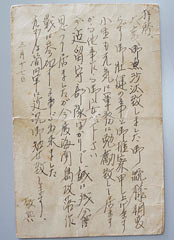
Katsue Garner kept this military postcard, which was returned home to Takako Kuwae.
Takako received the card at a ceremony held in Okinawa City Hall, and said, “When I first heard about the card, I was a little doubtful, but I recognized my father’s handwriting on it. I am grateful to her for keeping it safe.” Garner also commented, “I am glad that I came back, and am very happy to see Kuwae-san.”
The postcard was written to Koumei Arakaki when Kuwae was serving with the 4th Detachment on the Japanese cruiser Natori. In the card, Kuwae wrote, “I took part in the Hainan Island Operation.” It is thought that he wrote it after the Imperial Japanese Army attacked Hainan Island in China, in 1939.
Yoshifumi Kuwae was born in 1914, and after the war, he served as a local representative of Misato. Yasuaki Arakaki was born in 1881, served as a teacher and lived abroad. Kuwae died in 1999, and Arakaki in 1950.
(English translation by T&CT, Kyoko Tadaoka and Mark Ealey)
Go to Japanese
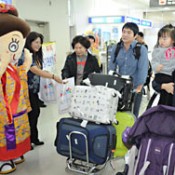
December 25, 2012 Ryukyu Shimpo
On December 24, the low-cost carrier Jin Air, a subsidiary of Korean Air, commenced regular flights between Naha and Inchon, Seoul. It was the first foreign low-cost carrier to begin a route to Okinawa. The first flight to Naha was full and 73.8 percent of capacity was occupied on the way back to Korea. The temperature in Seoul was – 13 C, so many people visited Okinawa to spend Christmas Eve in warm Okinawa.
Following on from Asiana Airlines, this is the second air carrier to commence regular flights on this route. It is the second route to Japan for Jin Air, after Seoul-Sapporo. Jin Air uses Boeing 737-800 aircraft, which have 183 seats, and operates one round-trip flight per day. During the campaign to mark the start of the new service, the lowest price of the flight was 4900 yen round-trip, but in the future it will be about 20000 yen for a round-trip, excluding fuel surcharges and tax.
According to the Okinawa Prefectural Government, the annual number of tourists from Korea in 2011 was 26000 people, up to 40.5 percent on the previous year. In the welcoming ceremony held at the international terminal of Naha Airport, vice governor of Okinawa Yoshiyuki Uehara, said that Okinawa has many cultural attractions, foods and facilities that Korean people can enjoy, and he hopes to see an increase in mutual exchange. The managing director of Jin Air, Hong-Geun Chong, said that Okinawa is a beautiful place, known as the Hawaii of the East. In Korea, it has become known for holding professional baseball team training camps and as a filming location for dramas. He would like many Koreans to utilize the new service to visit Okinawa.
(English translation by T&CT, Lima Tokumori and Mark Ealey)
Go to Japanese
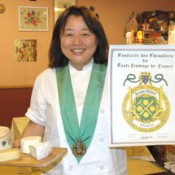
December 21, 2012 Ryukyu Shimpo
Midori Iizuka, owner chef of the Italian restaurant Tedako-tei received the French traditional cheese lovers’ title Confrérie des Chevaliers du Taste-Fromage.
Her restaurant serves several dishes with French cheese and her contribution to the increasing popularity of French cheese was praised by the Confrérie des Chevaliers du Taste-Fromage de France au Japan. She said, “I am very happy and want to do more to promote French cheese.”
On November 13, 2012, Iizuka and 19 others from around Japan attended an investiture in Tokyo in which the title Chevalier and a medal was given to each of them. She is the third chevalier from Okinawa.
Previously she was only using Italian cheese, but after participating in a French cheese appreciation tour in 2007, she was amazed by how delicious the French products are.
She now purchases French and other countries’ cheese from a specialty store in Tokyo and added those chesses, three cheese samplers, and other dishes to her appetizer menu. She said, “It is not a French restaurant, but I want everyone to try those cheeses. I want those really delicious cheeses to become more popular in
Okinawa and for people to enjoy them.”
(English translation by T&CT, Hitomi Shinzato and Mark Ealey)
Go to Japanese
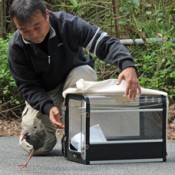
December 22, 2012 Ryukyu Shimpo
On December 19, a male Yambaru kuina or Okinawan rail that was saved from an attack by crows near the Okuni Forest Road in Taiho, Ogimi Village was released back into the forest. The place in which the Okinawan rail was rescued is at the southern limit of the Yambaru kuina. In order to protect the habitat of the bird, Okinawa Animal Hospital member Michio Kinjo, who looked after the rail, called for the extermination of crows and cats, which have increased in numbers because of human activity in the area.
Based on the pattern on its feathers, the rail in question seems to be a young bird. On November 27 at the Taiho Dam, a worker found the Okinawan rail after it had been attacked by several crows and reported the incident. When the Okinawan rail was found, it could hardly move, and was bleeding from its head and neck, with a scratch on its back and a hole in its head from being pecked by the crows.
After being released, the Okinawan rail ran quickly into the forest. According to Kinjo, three Okinawan rails have been seen in the Taiho area.
(English translation by T&CT, Megumi Chibana and Mark Ealey)
Go to Japanese
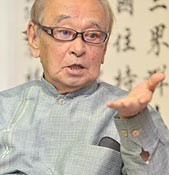
December 27, 2012 Ryukyu Shimpo
While new Prime Minister Shinzo Abe indicated that he will proceed with the plan to relocate the U.S. Marine Corps Air Station Futenma to Henoko in Nago, Okinawa Governor Hirokazu Nakaima reiterated that he would seek the alternative facility for Futenma outside of Okinawa. On December 26, at the press conference looking ahead to the New Year, the governor said, “The Noda administration had the same policy [to move the Futenma base to Henoko], but there is no change in my commitment.”
In addition, he questioned the feasibility of the current plan, stating, “Many people, including the mayors of 41 municipalities and all the members of the Okinawa Prefectural Assembly, are opposed to this, so the Henoko relocation plan will not go smoothly even if the government does actually start construction. I wonder if the government has really considered how feasible the plan is. Do they think that if they decide upon something, that it will just fall into place?”
With regard to the Senkaku Islands dispute between China and Japan, the governor pointed out that “It is a problem that will continue to cause tension. They get too emotional.” He commented, “[The government] should handle this issue considering the big-picture. I hope that the problem will be settled soon.”
Nakaima gave a negative response to the question about his possible candidacy for a third term as the governor, saying, “I am not a superman like former Tokyo Governor Shintaro Ishihara.” Eighty year-old Ishihara has returned to the House of Representatives.
The governor was critical of the fact that MV-22 Osprey aircraft have flown over residential areas in conversion-mode and have strayed off their designated flight path. The U.S. Marine Corps is planning to deploy an additional 12 Osprey aircraft to Futenma next year. Nakaima also demanded the cancellation of the deployment plan, saying, “Osprey aircraft can fly a long distance, so there is no reason for them to be deployed in Okinawa.”
(English translation by T&CT, Mark Ealey)
Go to Japanese
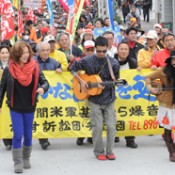
December 24, 2012 Ryukyu Shimpo
On December 23, a rally was held in Ginowan to protest against the deployment of the MV-22 Osprey to Okinawa, and against ongoing crime and incidents involving U.S. military personnel. About 3000 people from both inside and outside of the prefecture participated in the rally. After the rally at the Open Theater in Ginowan Seaside Park participants marched while singing songs. With this approach, the protesters used a range of methods to appeal to the U.S. and Japanese governments to withdraw the Osprey aircraft from Okinawa and to swiftly close and then remove U.S. military bases from the prefecture.
During the rally, Shiko Sakiyama, chairman of the Okinawa Peace Movement Center, said, “We should do our utmost to prevent next year’s planned full deployment of the Osprey, and then push for the removal of the bases.” The participants adopted a resolution stating that the people of Okinawa will protest against the deployment of the Osprey and ongoing crimes and incidents involving U.S. military personnel, and will continue to defy the U.S. and Japanese governments, and the U.S. military that force this unreasonable burden upon Okinawa.
The organizers launched this “Sound Demo” to allow people from different generations to protest participate peacefully and easily.
The participants marched about two kilometers from the Kankai Gate of Ginowan Seaside Park to the open area in front of the Oyama Gate of Futenma Air Station, where the Osprey aircraft are deployed.
The march split into ten groups led by vehicles carrying musicians active in Okinawa and beyond. They performed rock, folk and club, ethnic songs. People marched in a relaxed manner listening to the music performances dedicated to peace, as well as demanding the removal of the Osprey aircraft and the U.S. military bases from Okinawa.
Go to Japanese

Go To Video
January 1, 2013 Ryukyu Shimpo
The New Year is upon us. At the beginning of a year in which Japan marks the 68th anniversary of the end of the war, we would like to think about Japan following the path of a peaceful country. At the same time, we suggest that we look at the desired future for Okinawan society and press ahead with discussion at multiple levels among the Okinawan people about how peace, autonomy and independence should be.
The Japanese Constitution renounces war. The antiwar and antinuclear messages sent by Okinawa, which was the scene of the largest amphibious battle in the Pacific War, and Hiroshima and Nagasaki, upon which American bombers dropped atomic bombs, have for global community created an image of a Japan that has learned the lesson of history. These images are valuable assets for Japan. By pursuing our peace constitution our country spearheads a global drive to promote peace. This fact should also be the basis of every discussion involving Okinawa.
Unfair treatment of Okinawa by the Japanese and the U. S. governments
While revision of clauses of the constitution including Article Nine and the establishment of a National Defense Force, move closer to being realized under the administration of newly installed Prime Minister Shinzo Abe, opinion polls reveal that for Japanese citizens neither of these are priority issues.
The government should refrain from use weight of numbers to force through the implementation of policies that split public opinion, such as the increase in sales tax, participation in the Trans-Pacific Partnership, and policies on nuclear power plants.
Prior to moving towards a majority decision, a considered review would guarantee democratic validity to any policies implemented. We want both the Liberal Democratic Party and Komeito to display self-control.
Even more than in past years, Okinawa needs to exert a tenacious negotiating power in order to create peaceful and prosperous islands without any military bases.
The U.S. and Japanese governments are making steady progress on the plan to relocate U.S. Marine Corps Air Station Futenma to the Henoko district of Nago. Last October, the central government went ahead with the deployment to Okinawa of the MV-22 Osprey vertical take-off and landing transport aircraft that has a history of crashing.
Beyond the end of January the central government will move ahead with the application to reclaim the coastal area of Henoko for the relocation of the facilities at Futenma. It is highly likely that Okinawa Governor Hirokazu Nakaima will call for the relocation of the base outside of the prefecture and reject the application. If that happens, the central government may order the prefectural government to adjust its stance, execute the plan by proxy, or even sue the prefectural government.
The Okinawan people have rejected the Henoko relocation plan, and various American researchers, and former Defense Minister Satoshi Morimoto, have pointed out the irrationality, from a strategic viewpoint, of stationing the U.S. Marines in Okinawa. For all intents and purposes the plan does not stand up – it is ridiculous to go ahead with it. The U.S. and Japanese governments should review the agreement to relocate Futenma Air Station to Henoko, and resubmit a plan to relocate the base outside of the prefecture or outside of Japan, closing and removing the facilities currently at Futenma.
The U.S. and Japanese governments espouse freedom, democracy, respect for people, and rule of law as common values. If they are true to their word, they need to fundamentally review the unfair policies that impact upon Okinawa.
At the same time, Okinawa needs the imagination and flexibility to see the second term for Abe, who supported introducing a regional system, as an opportunity to expand its autonomy. The Regional Preferential Vision for Okinawa, which the Okinawa Regional System Advisory Conference proposed to Nakaima in September 2009, could serve as a useful reference.
Structural violence
The conference consists of educators in universities, people representing the Okinawan business community, labor circles and members of the prefectural assembly, and representatives of municipalities. In terms of moments that change the flow of events, they see the introduction of a regional system as being just as significant as the invasion of the Ryukyu Kingdom by forces of the Japanese feudal domain of Satsuma in 1609, the annexation of the Ryukyus in 1879, the implementation of Article Three of the Treaty of San Francisco that left Okinawa under potential U.S. trusteeship in 1952, and Okinawa’s reversion from U.S. rule to Japanese sovereignty in 1972. But the members of the conference asserted that even if a regional system were introduced, we should keep in mind that Okinawa could still be shaped by outside forces.
The vision suggests that to a significant extent the central government delegates the authority to a new Okinawa Government for matters such as the enforcement of duties and quarantines, immigration authority and coastal and border security, as well as the taxation of U.S. military forces stationed in Okinawa. It envisions the establishment of a new Okinawa Provincial Government.
In 2010, Yasukatsu Matsushima, professor of Ryukoku University, proposed the Ryukyu Autonomous Republic Federation Statehood Declaration. We hope that this year the people of Okinawa will further deepen discussion on the topics of autonomy and independence.
We want a peace movement to steadily develop. Johan Galtung, the principal founder of the discipline of peace and conflict studies and co-founder of TRANSCEND, a nongovernmental organization for conflict transformation by peaceful means, defines the absence of overt violent conflict as negative peace, and a state in which nations do not have structural violence, including poverty, oppression and discrimination that threaten safety and human rights, as positive peace.
What we push for is positive peace. A military alliance cannot remove structural violence. We suggest that through international collaboration and the power of the people, including nongovernmental organizations, we reduce the structural violence prevalent in Okinawa and the world. Okinawa needs to call for the global community to work together.
(English translation by T&CT, Mark Ealey)
Go to Japanese
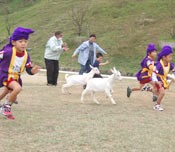
December 18, 2012 Ayako Sakaguchi of Ryukyu Shimpo
On January 8, at Oishi Park in Naha, people fond of goats, or hija as they are known in the Okinawan dialect, held a year-end party and was also designed to foster friendship among people in the community. Many people, including the elderly and local children, participated in the event sponsored by five groups such as the Oishi Park Hija-Lover Club. The participants enjoyed goat races and a contest to imitate the voice of goats. Naha City Mayor Takeshi Onaga made an appearance and imitated a goat’s voice. About 30 children, including some of kindergarten age and the children who were looking after the goats, took part in the race with the animals.
Tenshiro Hayashi, a four year-old boy from Emile Nursery School, said, “I ran as fast as I could in my race with yagi-san (goat), and I beat him. He was quite slow.”
The crowd burst into laughter when Mayor Onaga attempted to imitate a goat’s voice. Naha resident Masako Nakasone said, “The mayor’s imitation was the best. His having a go made us feel a little closer to him.”
Eiichi Oshiro, the chairperson of the Oishi Park Hija-Lover Club, said, “This was the first time for us to hold this fellowship event. Children now come over after school every day to help take care of the goats. We hope that this will be a relaxing place for people in the community, where people and their children will deepen their mutual bonds.”
(English translation by T&CT, Mark Ealey)
Go to Japanese











 Webcam(Kokusai Street)
Webcam(Kokusai Street)


